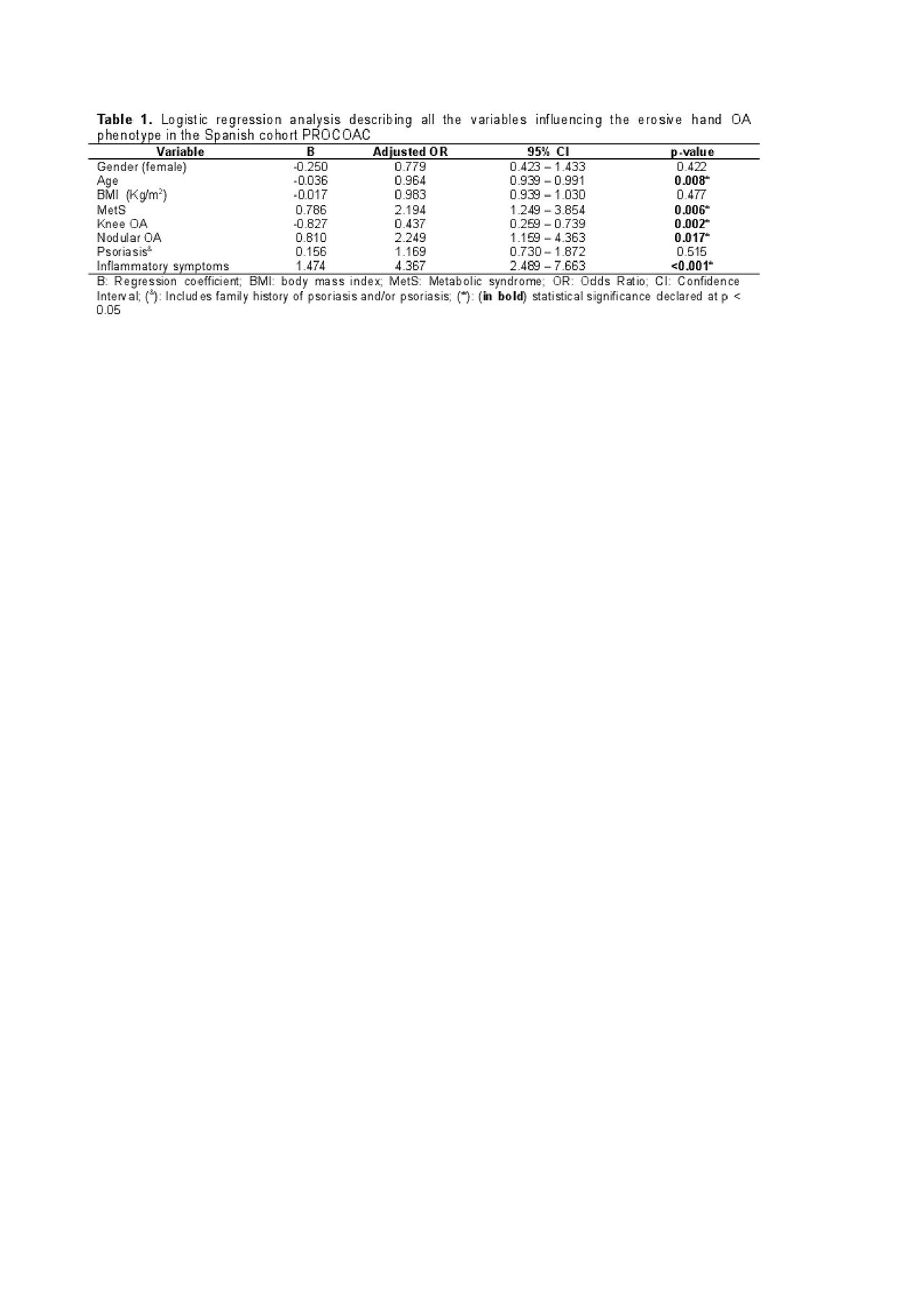Session Information
Session Type: Poster Session (Tuesday)
Session Time: 9:00AM-11:00AM
Background/Purpose: Erosive hand osteoarthritis (EOA) is often considered a more severe form of hand OA. However, more data are needed regarding this phenotype to conclude if represents a different subset of hand OA or a different degree of affectation of the same disease. The purpose of this work is to compare the clinical pattern of patients with EOA with those that do not show this phenotype
Methods: This cross-sectional study was conducted in the Prospective Cohort of Osteoarthritis A Coruna (PROCOAC). The cohort consists of 1136 subjects, of which 877 were diagnosed of hand OA following ACR criteria. After reviewing the x-rays, we split the cohort into patients with and without EOA, and subsequently analyzed both clinical and demographic data within each group, together with the assessment of the AUStralian CANadian Osteoarthritis Hand (AUSCAN) index. The study consisted in a Univariate analysis comparing different variables between both groups, followed by a stepwise regression logistic regression analysis.
Results: The mean age of the cohort was 63.61±9.03 years and consisted of 718 females and 159 males. Of the 877 OA patients, 167 had EOA. The
Univariate analysis revealed that patients with EOA were younger (59.85±7.95 vs 64.43±9.04;p< 0.001), smokers (p=0.008), with lower BMI (p=0.007), increased inflammatory episodes (p< 0.001), more presence of nodal OA (p=0.001), with family history or suffering psoriasis (p=0.046) and less number of damaged joints (p< 0.001), specially the knee (p< 0.001). In addition, despite the higher number of females suffering from hand OA, no significant differences between erosive and non-erosive phenotypes in terms of gender were detected.
The regression model (Table 1) confirmed the strong association of age (OR=0.964;95%CI=0.939-0.991;p=0.008), inflammatory episodes (OR=4.367;95%CI=2.489-7.663;p< 0.001) and increased prevalence of nodal OA (OR=2.249;95%CI=1.159-4.363;p=0.017) with the EOA. Interestingly, the model also showed MetS as a risk factor too, specifically over 64 years (OR=2.194;95%CI=1.249-3.854;p=0.006), with the tryglicerides content as the metabolic component most involved in this association (p=0.082). In addition, EOA patients show a lower prevalence of knee OA (OR=0.437;95%CI=0.259-0.739;p=0.002) and to carry this phenotype at baseline does not confer a significant increased risk for radiographic knee OA progression over time (p=0.515). The AUSCAN score showed significantly higher mean values in patients with the EOA: pain (58.66±28.78 vs 41.83±32.26; p< 0.001), function (56.19±27.44 vs 39.22±30.01; p< 0.001) and stiffness (55.47±32.34 vs 39.28±36.41;p=0.001).
Conclusion: EOA is associated with more inflammation in younger patients, and worst AUSCAN score. Contrarily to the non-erosive phenotype, the presence of erosions associates with a lower occurrence of other forms of OA, specially knee OA, as well as with no incidence on the radiographic knee OA progression. In our cohort, EOA seems to be more localized in the hand and it also seems to be associated with psoriasis and nodal OA.
To cite this abstract in AMA style:
Oreiro N, Rego-Pérez I, Silva M, Relaño S, Fernandez-Moreno M, Ramos-Louro P, Duran-Sotuela A, Pertega S, Blanco F. Erosive Hand Osteoarthritis, Metabolic Syndrome and Knee Osteoarthritis: A Cross-sectional Study Using Data from the PROCOAC Cohort [abstract]. Arthritis Rheumatol. 2019; 71 (suppl 10). https://acrabstracts.org/abstract/erosive-hand-osteoarthritis-metabolic-syndrome-and-knee-osteoarthritis-a-cross-sectional-study-using-data-from-the-procoac-cohort/. Accessed .« Back to 2019 ACR/ARP Annual Meeting
ACR Meeting Abstracts - https://acrabstracts.org/abstract/erosive-hand-osteoarthritis-metabolic-syndrome-and-knee-osteoarthritis-a-cross-sectional-study-using-data-from-the-procoac-cohort/

